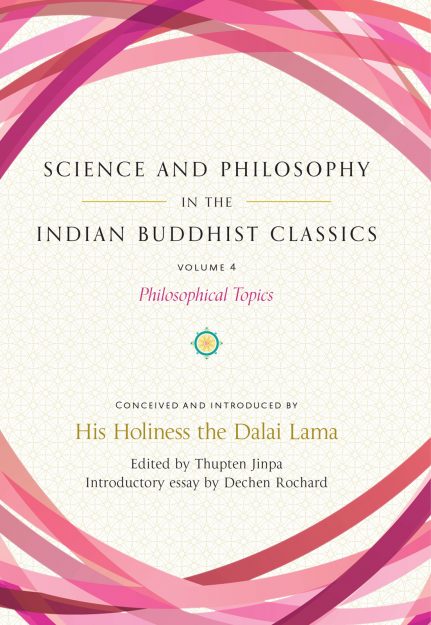The Tibetan Tengyur (bstan ‘gyur) is an encyclopedic collection of more than 3,500 Indian Buddhist texts, assembled in more than 200 volumes. It forms the second major part of the Tibetan Buddhist canon, and together with the Kangyur (bka’ ‘gyur), the collection of the discourses of the historical Buddha, constitutes the sum total of Indian Buddhist learning translated into Tibetan, the core and foundation of the Tibetan Buddhist intellectual world. The Tengyur, which means “translated treatises,” contains a varied collection of works, some commentarial, some independent. Among its contents are the great treatises of Indian Mahayana Buddhist philosophy, Madhyamaka and Yogacara; Tantric works; the Perfection of Wisdom (prajnaparamita) texts; commentaries on sutras; as well as works on logic, linguistics, poetry, and medicine.
Science and Philosophy in the Indian Buddhist Classics, volume 4
Edited By Thupten Jinpa,
Wisdom Publications, August 2023
640 pp., $29.95, paper
Recent years have seen the beginning of initiatives to translate the whole of the Tengyur into English, though we are still many decades, possibly even a century, away from its completion. (The 84,000 project, which aims to translate the entire Tibetan Buddhist canon, expects to complete the translation of the Tengyur by 2110.)
However, readers of English can get an impression of the vastness and intellectual depth of the Tengyur now, through individual works that have already been translated, and also through a remarkable new project brought out by Wisdom Publications. This four-volume series of books, called Science and Philosophy in the Indian Buddhist Classics, has just concluded with its final volume, Philosophical Topics.
The series was conceived by the Fourteenth Dalai Lama, who asked a group of Tibetan monastic scholars to produce a summary of the key scientific and philosophical contents of the Tibetan Buddhist canon. This Compendium Compilation Committee, chaired by Thamthog Rinpoche, abbot of Namgyal Monastery, produced a series of four Tibetan volumes, which have now been translated into English. With a total length of more than 2,000 pages, this is a formidable achievement.
The first volume covers the physical sciences, with discussion of ancient Indian Buddhist theories of matter, time, and cosmology, as well as a substantial section on embryology, while the second volume is devoted to the Buddhist sciences of the mind, providing an overview of Buddhist psychology, the mind’s constituents, inferential reasoning, and meditational mind training. The final two volumes focus on philosophy. The third volume surveys the ancient Indian philosophical cosmos seen through Tibetan eyes, presenting an account of the Buddhist conceptions of the main schools of Classical Indian philosophy. These include the Nyaya and Vedanta, as well as “unorthodox” schools like the Jains and the ancient Indian materialists, followed by a thorough presentation of the key schools of Abhidharma and Mahayana philosophy. The final volume offers a discussion of specific philosophical topics, such as the two truths and nonself, and provides an impression of the lively philosophical debates these topics sparked in ancient India.
Translating this demanding and often technical material was not an easy task, and Wisdom Publications assembled an impressive set of experts under the general editorship of Thupten Jinpa, the Dalai Lama’s principal English translator. The first volume was translated by Ian Coghlan, who has recently published a fine translation of Buddhapalita’s commentary of Nagarjuna’s Fundamental Verses on the Middle Way. The second was translated by Dechen Rochard (who also translated the fourth volume) and John Dunne. Rochard is a specialist on Madhyamaka and Candrakīrti, while Dunne is well-known for his work on Buddhist contemplative practice in dialogue with cognitive science. The third volume was translated by Donald S. Lopez Jr. and Hyoung Seok Ham. Lopez has recently translated a voluminous 18th-century Tibetan work on tenet systems (frameworks for understanding the nature of reality) for the Library of Tibetan Classics series; Ham is a distinguished Sanskritist and expert on the Classical Indian Mimamsa school. Volumes 2 and 3 also contain introductory contextual essays by Dunne and Lopez, respectively.
The fourth and final volume covers six central topics of Buddhist philosophy: the two truths, the no-self theory, ultimate reality according to Yogacara, emptiness in Madhyamaka, Buddhist epistemology and logic, and exclusion semantics, or apoha. (Exclusion semantics is a way of understanding a particular concept by eliminating everything that it isn’t.) With the exception of the theory of the two truths, which runs through the entirety of Indian Buddhist philosophy (described in greater detail in Sonam Thakchoe’s new magisterial The Two Truths in Indian Buddhism), the remaining five topics line up with the systems of tenets described in traditional Tibetan accounts: no-self with the Abhidharma, followed by Yogacara and Madhyamaka, and the final two topics with the school of Dinnaga and Dharmakirti. As these schools are treated in detail in volume 3 of the series, there is some overlap. We find discussions of the Yogacara theory of the three natures (trisvabhava) in both volumes 3 and 4; the same is true of the Svatantrika-Prasangika distinction, while matters of logic and inference are treated in much greater detail in volume 2. The interested reader will want to acquire all four volumes to ensure they do not miss relevant discussions elsewhere in the series.
Somewhat more concerning than the perhaps inevitable spread of discussions across separate volumes are the editors’ inconsistent translational choices. An unsystematic comparison of volumes 3 and 4 yields numerous examples: parikalpita-svabhava is rendered as “imaginary nature” in one volume and as “imputed nature” elsewhere; other cases include spyi (“generality” or “universal”), buddhi (“intellect” or “cognition”), akara (“image” or “aspect”), and so on. Why the publisher has not insisted that the translators harmonize their terminological choices at the outset of the project is unclear. Those familiar with the subject matter are unlikely to be confused by the examples of translational variation just mentioned; they are, after all, all reasonable English equivalents of the relevant Sanskrit and Tibetan terms. However, this volume is presumably intended for readers without prior acquaintance with the substantial Sanskrit and Tibetan technical vocabulary characterizing Indo-Tibetan philosophy. In an attempt to render dense, scholastic material, which frequently relies on precise definition of and differentiation between terms in English, a consistent choice of translations is essential. Tibetans themselves realized the importance of such terminological consistency when translating Sanskrit texts into Tibetan as early as the 9th century, and one would hope that a similar desire for translational coherence would also characterize contemporary endeavors, at least within the boundaries of a single project.
What is the intended audience for this series of books? These volumes occupy an interesting middle position between introductory overviews and primary sources. On the one hand, they constitute synoptic compendia, which bring together discussions of specific topics from various sources under a single heading; on the other hand, they are firmly rooted in the Tibetan scholastic tradition, sharing its expository style and focus on copious quotations from primary sources. The intended readership is clearly not the complete novice in the field. Leaving the differences in translational choices to one side, by the time someone who has never heard of Dinnaga, Dharmakirti, or exclusion semantics gets to sentences like the following, readers will probably have reached for a more elementary exposition of Buddhist philosophy:
“Conversely, in the case of negative concomitance or the heterogeneous class, although this is limitless like the homologous class, there is a difference in that the term, being absent from all dissimilar or heterogeneous cases, can be ascertained in a general way not to apply to those.” [4:478]
What these four volumes provide is an entrance into the thought- world of Tibetan philosophy.
Nor are the books meant as a substitute for reading the scholastic Buddhist treatises of ancient India or the Mahayana sutras. What these four volumes provide is an entrance into the thought-world of Tibetan philosophy, and the way it has made the Indian Buddhist tradition its own by systematizing, analyzing, and developing it. A reader who already has some familiarity with Abhidharma, Yogacara, and Madhyamaka, with the main problems these schools discuss, or with Buddhist theories of mind and meditation, will find an account of how the Tibetan tradition put these together as a single body of knowledge.
Indeed, it might be more accurate in this context to speak of the dominant stream of the Tibetan scholastic tradition. This reviewer would have been delighted to see more of the philosophical diversity of the Tibetan conceptions of the Indian sources represented in the series. Discussions of tathagatagarbha (buddhanature) theory and the philosophical complexities this entails are absent, for example. The status of epistemic instruments in Madhyamaka, a hotly debated issue in Tibetan scholasticism (for more on this, see the recent two-volume study by The Yakherds, Knowing Illusion, Oxford University Press, 2022), is presented exclusively from the perspective of Gelugpa orthodoxy. The focus of the series is of course the presentation of Indian Buddhist discussions, but nevertheless, one would hope that the reader does not go away with the impression that over the course of more than a thousand years in which Tibetans translated, studied, and analyzed Indian texts everybody in Tibet agreed on how these works were to be understood.
Despite minor flaws in translational coherence (which might be mitigated considerably if the publisher made available a searchable, cumulative version of the glossaries of the four volumes), this series constitutes a monumental achievement. It affords English-speaking readers a view of the contemporary Tibetan scholastic tradition from the inside, and allows them to see the conceptual and philosophical richness of Indian Buddhist literary culture through Tibetan eyes. Students of Indo-Tibetan Buddhism, and of the Indian intellectual tradition more generally, have every reason to be grateful to the Tibetan scholars making up the Compendium Compilation Committee, as well as to the English translators for providing them with this fantastic resource.
♦
From Science and Philosophy in the Indian Buddhist Classics © Edited by Thupten Jinpa. Reprinted with permission.

Thank you for subscribing to Tricycle! As a nonprofit, we depend on readers like you to keep Buddhist teachings and practices widely available.
